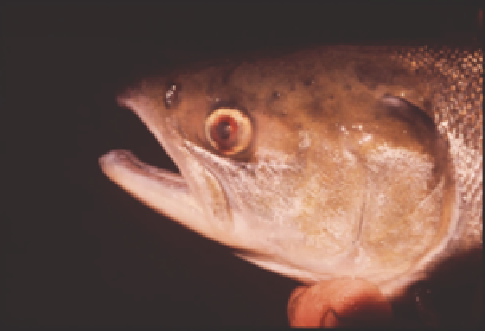Environmental Engineering Reference
In-Depth Information
equilibrium pressure exerted by the water just above the water surface (when the air is saturated
with water), as a function of temperature. At the water surface, the total gas pressure would be the
sum of the atmospheric pressure (the sum of the partial pressure of all gases) and the water vapor
pressure. The gas saturation is also strongly a function of pressure, so the greater the pressure is,
the greater the saturation concentration will be. Conversely, lower pressures, such as would occur
in the Rocky Mountains versus sea level, would result in lower saturation concentrations. In water,
the hydrostatic pressure increases with depth such that gas supersaturation decreases (or solubility
increases) by about 10% per meter of increase in water depth due to hydrostatic pressure.
Engineers are familiar with what happens with cavitation in pipe systems, which occurs when
the pressure head in the pipe (e.g., due to an increase in elevation and head loss in valves) falls below
the sum of the atmospheric and vapor pressures. Under reduced pressure, the saturation concentra-
tion of all gases or the total gas solubility drops and the liquid becomes supersaturated. As a result,
the liquid degasses and bubbles form, which can cause excessive wear or damage to pipes and pipe
parts. Similarly, the bends in human divers is also well known; it occurs when divers rise through
the water column and as the pressure decreases, bubbles form in the body.
In ish exposed to changes in pressure (changes in gas saturation concentrations and gas release),
bubbles may form in the gills, ins, eyes, and other body parts. The impacts can vary, but the bubbles
can block the blood low (form emboli or an embolism), causing overinlation of the swim bladder,
subdermal emphysema on the body surfaces, bulging of the eye (exophthalma), and other impacts
(Figures 18.5 and 18.6). The impacts can range from minor distress to death and can vary with the
type of ish, life stage, exposure time, and other factors.
The U.S. water quality criteria guideline for the protection of aquatic life from gas bubble disease
is that total dissolved gas (TDG) concentrations should not exceed 110% of the saturation value for
gases at the existing atmospheric and hydrostatic pressures (USEPA 1976).
Any condition that may result in rapid changes in gas solubility may result in gas bubble dis-
ease. These include rapid changes in temperatures or pressures. The rapid heating of cold saturated
waters such as in power plant or hydropower releases may also result in bubble release and gas
bubble disease. For reservoir tailwaters, one common and problematic cause is due to the spill of
waters. As water falls over a spillway, it entrains air, and when pressures increase by the impact
and as the water plunges into a stilling basin, the TDG concentration increases. This is a transient
condition, so that soon afterward, as pressures decrease, the total gas solubility decreases and the
water will degas, releasing the excess gas into solution.
The areas below spillways attract ish, and this congregation of ish creates a problem for many
reservoirs when they are exposed to excess TDG, particularly those with salmonids. For example,
FIGURE 18.5
Close-up of left eye of sockeye salmon aflicted with gas bubble disease. (From USEPA
National Environmental Research Center; Photo by Gene Daniels, 1970.)

Search WWH ::

Custom Search